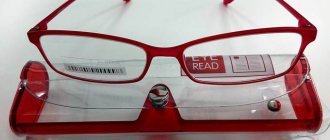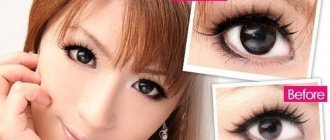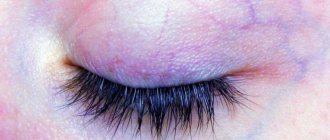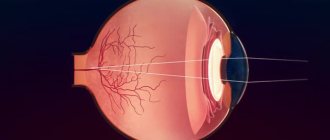Many people after 40 years are forced to correct an eye disease such as presbyopia - age-related farsightedness. The best way to do this is with multifocal lenses. To select them, the doctor will need not only standard eye parameters, but also an indicator called addition.
To understand how to select contact optics for addition, you must first understand what presbyopia is? Why does this pathology occur and how do multifocal lenses for eyes work?
Why does presbyopia occur?
A refractive error such as presbyopia occurs in people aged 40-45 years. It is due to the fact that the lens loses its elasticity, becomes hard and stops changing its shape when focusing vision on objects located at different distances from the eyes. As a result, the patient cannot see the world around him independently, without the use of vision-correcting agents.
Disadvantages of progressive glasses
The patient should be aware of the difficulties that he may encounter during the period of adaptation to progressive glasses and be prepared for them:
- a longer period of adaptation compared to monofocal glasses - there are no specific deadlines, in some cases adaptation can last a month, but this should be said in order to avoid misunderstandings;
- restriction of head movements up and down when working at close distances - at the time of marking, you should focus on this and offer a short corridor if a long one is inconvenient;
- a greater number of distortions when looking through the peripheral part of the lenses in comparison with monofocal glasses - at the beginning of wearing, try to look through the center of the lenses;
- difficult to see when looking at your feet while walking (problems with stairs, holes, puddles) - to see better, you will have to tilt your head lower.
10 tips to help your patients quickly get used to new glasses
What are multifocal contact lenses?
One of the simplest ways to correct presbyopia in ophthalmological practice is to use two pairs of glasses with different optical parameters to view objects at different distances. However, it is not very convenient, since it forces you to regularly change glasses depending on the situation, hampers movement and does not allow you to lead an active lifestyle.
Therefore, ophthalmologists recommend choosing the best alternative option for correcting presbyopia - multifocal lenses for the eyes.
The peculiarity of such products is that in each of them several optical zones with different indicators are simultaneously located, so the user can clearly see objects at different distances from him.
The simplest type of multifocal lenses are bifocal ophthalmic products with two optical zones and a clear boundary between them. That is, in the lower part of the lens there is a zone of near vision, and in the upper part there is a zone responsible for good distance vision.
There are also concentric lenses, which have alternating ring zones for viewing objects near and far. In total, such products have 2-3 zones.
The design of concentric contact lenses varies depending on which zone is in the center. In some models, the central circular zone is responsible for distance vision, and around it there is a ring for near vision. It also happens that the central part of the product, on the contrary, is responsible for good quality of vision at a distance.
Light rays hitting the visual organs first pass through all areas of multifocal contact lenses and form an image on the retina. It has been scientifically proven that the human brain selects the necessary image obtained through optical products and forms the final visual image.
Ophthalmologists also recommend choosing aspherical contact optics, which fully replaces progressive spectacle lenses.
In such products, the refractive power changes from the central part to the peripheral part. So, if the central zone is responsible for near vision, when viewing nearby objects, the pupil narrows. Conversely, when looking at an object at a distance, the pupil dilates. Because the transitions between zones in aspheric lenses are quite smooth, they provide excellent vision at intermediate distances.
If, when wearing bifocal lenses, a stable position of the product on the eye is necessary, then concentric and aspheric contact optics do not require this. It is also important to understand that multifocal lenses are not suitable for patients with high add.
Selection of additions for progressive glasses
The main thing here is not to overdo it. The greater the addition, the more distortions will form on the periphery of the lens and there will already be zones of clear vision (especially the transition zone), which means it will be more difficult for the patient to get used to such glasses. The addition often turns out to be overestimated due to incorrectly selected correction for the distance. If, when selecting a correction for the distance, you adhere to the rule “minimum minus, maximum plus,” then everything should be in order with the addition. There are many ways to select an add-on, but it is difficult to say which one gives the greatest reproducibility of results and patient satisfaction. [18]
A brief algorithm for selecting spectacle correction and conducting clarifying tests
Lens addition: what is it?
Such a parameter as addition in contact lenses is very important when selecting optical products. It shows the optical power, which is necessary as an additional force when viewing distant objects, but at the same time allows you to clearly see close objects. This parameter is indicated in the recipe along with others and is designated “ADD” or “add”. This characteristic may differ in the right and left eyes. Thus, lens addition as a plus addition near is measured as: low - LOW up to +1; average - MEDIUM from 1.25 to +2; high - HIGH over +2.
It is important to understand that on your own, without a vision test by a specialist and his recommendations, you will not be able to choose contact optics that will correct your vision and provide an ideal image, since such a parameter as addition is individual.
Parameters of lenses for vision correction
The main properties characterizing contact lenses include:
- optical power (or diopter);
- radius of curvature;
- diameter.
The first indicator is a characteristic expressed in positive and negative values, which are indicated in numbers (“+” and “-”). The unit of measurement is dioptres.
The corrector sphere is concentrated in its central part.
If a person wears bifocal contact lenses, then for each organ of vision there are 2 main properties of optical power.
If astigmatism is detected, 2 more qualities are added to the indicated qualities. They are required for the selection of toric correction means. The following characteristics are relevant:
- cylinder. This is a value with negative exponents that determines the optical power of the specified vision deviation. Cylinder values range from -0.75 to -2.25. The lenses help improve visual function with astigmatism, and also suppress pain in the eyes and head;
- tilt axis. This indicator is related to the angle of inclination of a particular type of astigmatism. Range - from 90 to 180 degrees.
The radius of curvature of lenses in optics depends on the individual structural features of the human eyeball. This indicator can be standard or non-standard. In the first case, the parameter will be 8.6 and 8.7, in the second - 8.3 and 9.0.
The diameter of the products is calculated in millimeters. The spectrum of this indicator usually ranges from 13 to 15 mm. In most cases, the diameter value is the same for both organs of vision.
Only an ophthalmologist can select each parameter.
Patient age and addition
Addition is the difference between the diopters required for simultaneous correction of near and far vision at a distance of an average of 30-40 cm. Thus, in youth there is no difference between the ability to see near and far, so a person distinguishes objects with the same diopters equally well. With age, the situation begins to change. There is a need to use additional positive diopters. The addition for people with myopia and hypermetropia is the same. In ophthalmological practice there are approximate calculations of this indicator for various age categories:
- At 40 years old - + 0.5-0.75 diopters;
- At 45 years old - + 1-1.25 diopters;
- At 50 years old - + 1.5-1.75 diopters;
- At 55 years old - + 2 diopters;
- At 60 years old - + 2.25-2.5 diopters;
- At 65 years old - + 2.75-3 diopters.
Addition of multifocal lenses is achieved, as mentioned earlier, due to a smooth transition between optical zones from the central part to the middle, and then to the periphery.
Selection of progressive lenses
Currently, manufacturers are increasingly offering lenses of optimized and individual design, taking into account the patient’s requirements related to his type of activity, anatomical features, habits and the chosen frame. Recommendations for design selection are based on small studies with small samples, often supported by optical companies, which show only a statistically significant difference in favor of more complex designs - an increase in the area of clear vision, easier adaptation, better contrast sensitivity and quality of vision. However, clinical assessment methods are not sufficiently sophisticated to compare standard and personalized lenses, so results in real-world practice may be highly subjective. [20-29]
Optimized lenses involve reducing the thickness and weight of the lens by more accurately calculating the diameter and attempting to create more comfortable vision in 1-2 preferred visual zones.
Individual lenses, in addition to choosing preferences for visual zones, allow you to deviate from standard parameters when choosing a frame, but the range is still limited by the technical capabilities of production. Therefore, before ordering such lenses, measure the vertex distance in the trial and selected frames, the pantoscopic angle of the frame, the bending angle of the frame and check with the manufacturer’s catalog.
To get an idea of how these and many other parameters affect the result, you can use the calculators on Darryl Meister's website OptiCampus.com and his Spectacle Optics program.
How do ophthalmologists determine addition?
There are several ways that allow a specialist to identify the necessary addition in a patient. Often, special tables are used to determine this indicator, which also make it possible to determine visual acuity when examining objects that are nearby. Next, they select a spherical lens with positive diopters and ask the person to read the text from a comfortable distance. This method is gradually becoming obsolete, because it does not give an accurate result. That is why doctors are increasingly using it as a guideline.
In addition, addition is measured using close retinoscopy also from the required working distance. The patient is required, under conditions of full distance correction, to read the text located on the retinoscope just above the lighting device. If accommodation is not impaired, during the examination the doctor will note the neutralization of the shadow. In the presence of presbyopia and weakened accommodative function, the shadow will shift in the direction of movement of the retinoscope. In the second case, the specialist will add “plus” lenses to the subject, increasing their optical power until the shadow is completely neutralized.
Many ophthalmologists note that this method is not sufficiently objective, since it directly depends on the qualifications of the specialist.
The most optimal method in practice is to determine addition using a binocular “open field” refractometer. It eliminates the possibility of errors and gives the most accurate results, which means it allows you to choose the correct vision-correcting contact optics.
Variable insertion in progressive glasses
Inset
— in optics, this is the ability to produce a progressive lens with a zone shift for close to the nose, which corresponds to the normal position of the eyes when working close.
Standard Inset
calculated in production. It depends on the working distance and addition and is about 2-2.5 mm for each eye.
Variable Inset
is an option that is used when ordering customized or optimized lenses for patients with reduced convergence for whom a standard insert is not suitable.
Inset in progressive glasses
From different manufacturers, the markings may vary or be selected with an accuracy of 0.1 mm, but approximately it looks like this: INSET = 100% - with normal convergence; INSET = 50% - with reduced convergence (10‒20 cm); INSET = 0% - with weak convergence (more than 20 cm).
Prescription for progressive glasses
The prescription for progressive glasses is as follows:
| Sph | Cyl | Ax | Add | Pr | Bas | D.P. | |
| O.D. | -2,00 | -1,00 | 90 | 1,50 | — | — | 32,0 |
| OS | -3,00 | -0,50 | 100 | 1,50 | — | — | 31,0 |
The notes indicate the lens type, progression corridor and insert.
Glasses prescription: explanation











